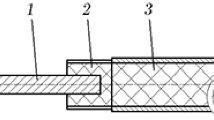Abstract
The detonation pressure of an emulsion explosive sensitized by polymer microballoons was determined using two loading schemes: a detonation wave normally incident on the target and sliding detonation. The initial density of the explosive ranged from 0.2 to 1.2 g/cm3. The obtained pressures are in good agreement with the calculated values known from the literature and are compared with the detonation pressures of an emulsion explosive sensitized by glass microballoons. The reaction time and the isentropic exponent of the emulsion explosive were calculated.
Similar content being viewed by others
References
Wang Xuguang, Emulsion Explosives (Metallurgical Industry Press, Beijing, 1994).
E. B. Kolganov and V. A. Sosnin, Industrial Emulsion Explosives (Kristal, Dzerzhinsk, 2009) [in Russian].
H. Yoshida, M. Iida, K. Tanaka, M. Kusakabe, and K. Shiino, “Detonation Behavior of Emulsion Explosives Containing Glass Microballoons,” in Proc. 8th Int. Symp. on Detonation (Albuquerque, 1985), pp. 171–177.
J. Cooper and G. Leiper, “Void Size Dependence of the Steady Detonation Properties of Emulsion Explosives,” J. Energ. Mater. 7, 405–417 (1989).
J. Lee, F. W. Sandstrom, B. G. Craig, and P.-A. Persson, “Detonation and Shock Initiation Properties of Emulsion Explosives,” in Proc. 9th Int. Symp. on Detonation (Portland, Oregon, 1989), pp. 263–271.
V. V. Sil’vestrov and A. V. Plastinin, “Investigation of Low Detonation Velocity Emulsion Explosives,” Fiz. Goreniya Vzryva 45(5), 124–133 (2009) [Combust., Expl., Shock Waves 45(5), 618–626 (2009).
A. G. Anshits, N. N. Anshits, A. A. Deribas, S. M. Karakhanov, N. S. Kasatkina, A. V. Plastinin, A. Yu. Reshetnyak, and V. V. Sil’vestrov, “Detonation Velocity of Emulsion Explosives Containing Cenospheres,” Fiz. Goreniya Vzryva 41(5), 119–127 (2005) [Combust., Expl., Shock Waves 41(5), 591–598 (2005)].
Ya.-F. Cheng, H.-H. Ma, and Zh.-W. Shen, “Detonation Characteristics of Emulsion Explosives Sensitized by MgH2,” Fiz. Goreniya Vzryva 49(5), 120–125 (2013) [Combust., Expl., Shock Waves 49(5), 614–619 (2013)].
V. A. Sosnin and E. V. Kolganov, “Detonation Process in Industrial Emulsion Explosives,” Khim. Fiz. 22(8), 100–107 (2003).
R. Mendes, J. Ribeiro, I. Plaksin, J. Campos, and B. Tavares, “Differences between Emulsion Explosives Sensitized with Glass or with Polymer Microballoons,” in 2013 Joint APS-SCCM/AIRAPT Conf., J. Phys.: Conf. Ser. 500, 052030 (2014); DOI: 10.1088/1742-6596/500/5/052030.
Y. Hirosaki, K. Murata, Y. Kato, and S. Itoh, “Detonation Characteristics of Void Size and Volume,” in Proc. 12th Int. Detonation Symp. (San Diego, 2002), pp. 263–270.
A. S. Yunoshev, A. V. Plastinin, and S. I. Rafeichik, “Detonation Velocity of an Emulsion Explosive Sensitized with Polymer Microballoons,” Fiz. Goreniya Vzryva 53(6), 132–137 (2017) [Combust., Expl., Shock Waves 53 (6), 738–743 (2017).
D. Price, “Contrasting Patterns in the Behavior of High Explosives,” in Proc. 11th Symp. (Int.) on Combustion, 1966 (The Combustion Inst., Pittsburgh, 1967), pp. 693–702.
A. S. Yunoshev, A. V. Plastinin, and V. V. Sil’vestrov, “Effect of the Density of an Emulsion Explosive on the Reaction Zone Width,” Fiz. Goreniya Vzryva 48(3), 79–88 (2012) [Combust., Expl., Shock Waves 48 (3), 319–327 (2012)].
A. S. Yunoshev, A. V. Plastinin, S. I. Rafeichik, and M. S. Voronin, “Acceleration Ability of Emulsion Explosives,” Fiz. Goreniya Vzryva 54(4), 123–129 (2018) [Combust., Expl., Shock Waves 54 (4), 496–501 (2018)].
J. A. Sanchidrián, R. Castedo, L. M. López, P. Segarra, and A. P. Santos, “Determination of the JWL Constants for ANFO and Emulsion Explosives from Cylinder Test Data,” CEJEM 12(2), 177–194 (2015).
Hakan Hanson, “Determination of Properties for Emulsion Explosives using Cylinder Expansion Tests and Numerical Simulation,” Swebrec Rep. 2009:1 (Univ. of Technology, Stockholm, 2009).
V. V. Sil’vestrov, S. A. Bordzilovskii, S. M. Karakhanov, and A. V. Plastinin, “Temperature of the Detonation Front of an Emulsion Explosive,” Fiz. Goreniya Vzryva 51(1), 135–142 (2015) [Combust., Expl., Shock Waves 51 (1), 116–123 (2015)].
A. Lefrancois, J.-V. Grouffal, P. Bouinot, and S. Men-cacci, “Temperature Emulsion Explosives and Pressure Measurements Detonation Front and Products Expansion,” in Proc. 12th int. Detonation Symp., San Diego, 2002, pp. 432–439.
A. S. Yunoshev, V. V. Sil’vestrov, A. V. Plastinin, and S. I. Rafeichik, “Influence of Artificial Pores on the Detonation Parameters of an Emulsion Explosive,” Fiz. Goreniya Vzryva 53(2), 91–97 (2017) [Combust., Expl., Shock Waves 53 (2), 205–210 (2017)].
S. A. Bordzilovskii, S. M. Karakhanov, A. V. Plastinin, S. I. Rafeichik, and A. S. Yunoshev, “Detonation Temperature of an Emulsion Explosive with a Polymer Sen-sitizer,” Fiz. Goreniya Vzryva 53(6), 123–131 (2017) [Combust., Expl., Shock Waves 53 (6), 730–73 (2017)].
V. V. Sil’vestrov, A. V. Plastinin, and A. S. Yunoshev, “Loading of an Emulsion by High-Velocity Plate Impact,” Fiz. Goreniya Vzryva 52(3), 114–118 (2016) [Combust., Expl., Shock Waves 52 (3), 358–362 (2016)].
S. Paul De Carli, “Manganin Stress Gage Calibration to 125 GPa,” Bull. Amer. Phys. Soc. 2(11), 1286 (1976).
H. C. Vantine, L. M. Erickson, and J. A. Jansen, “Hysteresis-Corrected Calibration of Manganin under Shock Loading,” J. Appl. Phys. 51(4), 1957–1962 (1980).
B. G. Loboiko and S. N. Lyubyatinskii, “Reaction Zones of Detonating Solid Explosives,” Fiz. Goreniya Vzryva 36(6), 45–64 (2000) [Combust., Expl., Shock Waves 36 (6), 716–732 (2000)].
A. N. Dremin, S. D. Savrov, V. S. Trofimov, and K. K. Shvedov, Detonation Waves in Condensed Matter (Nauka, Moscow, 1970) [in Russian].
V. V. Selivanov, I. F. Kobylkin, and S. A. Novikov, Explosive Technologies (Izd. MGTU Baumana, Moscow, 2008) [in Russian].
K. Tanaka, “Shock Compression of Solid with Voids by Gridless Lagrangian SPH,” in Shock Compression of Condensed Matter, July 31 to August 5, 2005; AIP Conf. Proc. 845 (2005).
Author information
Authors and Affiliations
Corresponding author
Additional information
Original Russian Text © A.S. Yunoshev, S.A. Bordzilovskii, M.S. Voronin, S.M. Karakhanov, S.N. Makarov, A.V. Plastinin.
Published in Fizika Goreniya i Vzryva, Vol. 55, No. 4, pp. 60–68, July–August, 2019.
Rights and permissions
About this article
Cite this article
Yunoshev, A.S., Bordzilovskii, S.A., Voronin, M.S. et al. Detonation Pressure of an Emulsion Explosive Sensitized by Polymer Microballoons. Combust Explos Shock Waves 55, 426–433 (2019). https://doi.org/10.1134/S0010508219040087
Received:
Revised:
Accepted:
Published:
Issue Date:
DOI: https://doi.org/10.1134/S0010508219040087



